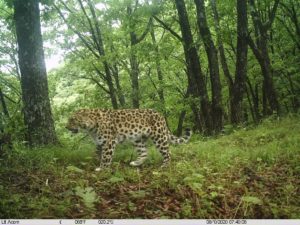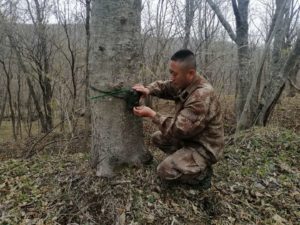The latest report to WildCats from WCS on the Amur leopard and tiger populations in China contains positive news.
WCS has been working in northeast China since 1998 and were instrumental in the creation of Hunchun Nature Reserve (HNR) in 2001, without a doubt the most important entry point for tigers and leopards to move from Russia into China. Since the reserve’s creation, WCS has assisted HNR to become a more effective protected area, including assisting with snare removals, patrol strategy (e.g., SMART*), tiger and leopard science, and tackling human-tiger conflict. More recently, they have helped the management of the new 15000km2 Northeastern Tiger and Leopard National Park (TLNP) define conservation and management priorities related to anti-poaching, reserve design, and population monitoring.
Together with the WCS team across the border, WCS China is developing an effective transboundary monitoring system as the first step in transboundary collaboration. Ultimately, progress in this arena is dependent on the governments of both China and Russia and the managers of Protected Areas on both sides. TLNP has incorporated SMART* into the park patrol system and established a unified database with the assistance, training and evaluation feedback from WCS China. This will have a positive impact on law enforcement in the park.
Both species continue to disperse from source populations in Russia, and WCS is documenting the increase in both Amur leopard and tiger populations in China.
Project activities and key achievements
- Two areas covering 630 km2 were camera trapped using 140 camera at 70 sites.
- In total 116,022 images and videos of wildlife and human activity were taken.
- 59% of all images were of human activities, mostly for harvesting non-timber forest products.
- Amur tigers were seen at 49% of the sites.
- Amur leopards were photographed 29% of sites.
- 17% of sites revealed pictures of both species.
- 17 individual tigers and 11 individual leopards were identified.
- Of the 11 leopards photographed, 4 were recorded in the past and 7 were seen for the first time.
- Snow tracking for 5 days in Dahuanggou forestry farm following 3 sets of tiger tracks for a total of 61km.
- 6 people trained in tracking methodology and identification in snow tracking.
- A webinar was held for park staff on the use of SMART system in place of a face-to-face workshop.
- SMART* databases from 10 branches of the TLNP were analysed and evaluated by the WCS team who provided feedback and recommendations.
*SMART – Spatial Monitoring and Reporting Tool

Amur tiger December 2020 © WCS

Amur leopard August 2020 © WCS

Checking the cameras © WCS China

